Animal husbandry

Animal husbandryis the branch ofagricultureconcerned withanimalsthat are raised formeat,fibre,milk,or other products. It includes day-to-day care, management, production, nutrition,selective breeding,and the raising oflivestock.Husbandry has a long history, starting with theNeolithic Revolutionwhen animals were firstdomesticated,from around 13,000 BC onwards, predating farming of thefirst crops.During the period of ancient societies likeancient Egypt,cattle,sheep,goats,andpigswere being raised on farms.
Major changes took place in theColumbian exchange,when Old World livestock were brought to the New World, and then in theBritish Agricultural Revolutionof the 18th century, when livestock breeds like theDishley Longhorncattle andLincoln Longwoolsheep were rapidly improved by agriculturalists, such asRobert Bakewell,to yield more meat, milk, andwool.A wide range of other species, such ashorse,water buffalo,llama,rabbit,andguinea pig,are used as livestock in some parts of the world.Insect farming,as well asaquacultureoffish,molluscs,andcrustaceans,is widespread. Modern animal husbandry relies onproduction systemsadapted to the type of land available.Subsistence farmingis being superseded byintensive animal farmingin the more developed parts of the world, where, for example, beef cattle are kept in high-densityfeedlots,and thousands ofchickensmay be raised in broiler houses orbatteries.On poorer soil, such as in uplands, animals are often kept more extensively and may be allowed to roam widely, foraging for themselves. Animal agriculture at modern scale drivesclimate change,ocean acidification,andbiodiversity loss.
Most livestock areherbivores,except for pigs and chickens which areomnivores.Ruminantslike cattle and sheep are adapted to feed on grass; they can forage outdoors or may be fed entirely or in part on rations richer in energy and protein, such as pelleted cereals. Pigs and poultry cannot digest thecellulosein forage and require other high-protein foods.
Etymology
[edit]The verbto husband,meaning "to manage carefully", derives from an older meaning ofhusband,which in the 14th century referred to the ownership and care of a household or farm, but today means the "control or judicious use of resources", and in agriculture, the cultivation of plants or animals.[1]Farmersandrancherswho raise livestock are considered to practiceanimal husbandry.
History
[edit]Birth of husbandry
[edit]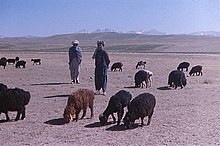
Thedomesticationof livestock was driven by the need to have food on hand when hunting was unproductive. The desirable characteristics of a domestic animal are that it should be useful to the domesticator, should be able to thrive in his or her company, should breed freely, and be easy to tend.[2]Domestication was not a single event, but a process repeated at various periods in different places. Sheep and goats were the animals that accompanied thenomadsin the Middle East, while cattle and pigs were associated with more settled communities.[3]The first wild animal to be domesticated was thedog.Half-wild dogs, perhaps starting with young individuals, may have been tolerated as scavengers and killers of vermin, and being naturallypack hunters,were predisposed to become part of the human pack and join in the hunt. Prey animals, sheep, goats, pigs and cattle, were progressively domesticated early in the history of agriculture.[3]Pigs were domesticated in theNear Eastbetween 8,500 and 8000 BC,[4]sheep and goats in or near theFertile Crescentabout 8,500 BC,[5]and cattle from wildaurochsin the areas of modern Turkey and Pakistan around 8,500 BC.[6]A cow was a great advantage to a villager as she produced more milk than her calf needed, and her strength could be put to use as aworking animal,pulling a plough to increase production of crops, and drawing a sledge, and later a cart, to bring the produce home from the field. Draught animals were first used about 4,000 BC in the Middle East, increasing agricultural production immeasurably.[3]
In southern Asia, theelephantwas domesticated by 6,000 BC.[7]Fossilised chicken bones dated to 5040 BC have been found in northeastern China, far from where their wild ancestors lived in the jungles of tropical Asia, but archaeologists believe that the original purpose of domestication was for the sport ofcockfighting.[8]Meanwhile, in South America, thellamaand thealpacahad been domesticated, probably before 3,000 BC, as beasts of burden and for their wool. Neither was strong enough to pull a plough which limited the development of agriculture in the New World.[3]Horses occur naturally on the steppes of Central Asia and their domestication began around 3,000 BC in theBlack SeaandCaspian Searegion. Although horses were originally seen as a source of meat, their use aspack animalsand for riding followed. Around the same time, thewild asswas being tamed in Egypt.Camelswere domesticated soon after this,[9]with theBactrian camelinMongoliaand theArabian camelbecoming beasts of burden. By 1000 BC, caravans of Arabian camels were linking India with Mesopotamia and the Mediterranean.[3]
Ancient civilisations
[edit]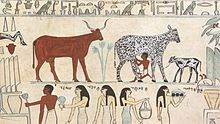
Inancient Egypt,cattle were the most important livestock, and sheep, goats, and pigs were also kept; poultry including ducks, geese, and pigeons were captured in nets and bred on farms, where they were force-fed with dough to fatten them.[10]The Nile provided a plentiful source of fish.Honey beeswere domesticated from at least the Old Kingdom, providing both honey and wax.[11]Inancient Rome,all the livestock known in ancient Egypt were available. In addition, rabbits were domesticated for food by the first century BC. To help flush them out from their burrows, thepolecatwas domesticated as theferret,its use described byPliny the Elder.[12]
Medieval husbandry
[edit]
In northern Europe, agriculture including animal husbandry went into decline when the Roman empire collapsed. Some aspects such as the herding of animals continued throughout the period. By the 11th century, the economy had recovered and the countryside was again productive.[13]TheDomesday Bookrecorded every parcel of land and every animal in England: "there was not one single hide, nor a yard of land, nay, moreover... not even an ox, nor a cow, nor a swine was there left, that was not set down in [the king's] writ."[14]For example, the royalmanorofEarleyinBerkshire,one of thousands of villages recorded in the book, had in 1086 "2 fisheries worth [paying tax of] 7s and 6d [each year] and 20 acres of meadow [for livestock]. Woodland for [feeding] 70 pigs."[15]The improvements of animal husbandry in the medieval period in Europe went hand in hand with other developments. Improvements to the plough allowed the soil to be tilled to a greater depth. Horses took over from oxen as the main providers of traction, new ideas oncrop rotationwere developed and the growing of crops for winter fodder gained ground.[16]Peas, beans and vetches became common; they increased soil fertility through nitrogen fixation, allowing more livestock to be kept.[17]
Columbian exchange
[edit]Exploration and colonisation of North and South America resulted in the introduction into Europe of such crops as maize, potatoes, sweet potatoes and manioc, while the principal Old World livestock – cattle, horses, sheep and goats – were introduced into the New World for the first time along with wheat, barley, rice and turnips.[18]
Agricultural Revolution
[edit]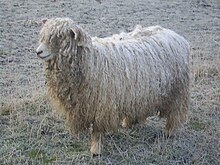
Selective breedingfor desired traits was established as a scientific practice byRobert Bakewellduring theBritish Agricultural Revolutionin the 18th century. One of his most important breeding programs was with sheep. Using native stock, he was able to quickly select for large, yet fine-boned sheep, with long, lustrous wool. TheLincoln Longwoolwas improved by Bakewell and in turn the Lincoln was used to develop the subsequent breed, named the New (or Dishley) Leicester. It washornlessand had a square, meaty body with straight top lines.[19]These sheep were exported widely and have contributed to numerous modern breeds. Under his influence, English farmers began to breedcattlefor use primarily as beef. Long-horned heifers were crossed with the Westmoreland bull to create theDishley Longhorn.[20]
The semi-natural, unfertilised pastures formed by traditional agricultural methods in Europe were managed by grazing and mowing. As the ecological impact of this land management strategy is similar to the impact of such natural disturbances as grazing andwildfire,this agricultural system shares many beneficial characteristics with a natural habitat, including the promotion ofbiodiversity.This strategy is declining in Europe today due to the intensification of agriculture. The mechanized and chemical methods used are causing biodiversity to decline.[21]
Practices
[edit]Systems
[edit]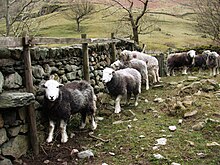
Traditionally, animal husbandry was part of thesubsistence farmer'sway of life, producing not only the food needed by the family but also the fuel, fertiliser, clothing, transport and draught power. Killing the animal for food was a secondary consideration, and wherever possible its products such as wool, eggs, milk and blood (by theMaasai) were harvested while the animal was still alive.[22]In the traditional system oftranshumance,people and livestock moved seasonally between fixed summer and winter pastures; inmontaneregions the summer pasture was up in the mountains, the winter pasture in the valleys.[23]
Animals can be kept extensively or intensively. Extensive systems involve animals roaming at will, or under the supervision of a herdsman, often for their protection frompredators.Ranchingin theWestern United Statesinvolves large herds of cattle grazing widely over public and private lands.[24]Similar cattle stations are found in South America, Australia and other places with large areas of land and low rainfall. Ranching systems have been used forsheep,deer,ostrich,emu,llamaandalpaca.[25]
In the uplands of the United Kingdom, sheep are turned out on the fells in spring and graze the abundant mountain grasses untended, being brought to lower altitudes late in the year, with supplementary feeding being provided in winter.[26]In rural locations,pigsandpoultrycan obtain much of their nutrition from scavenging, and in African communities, hens may live for months without being fed, and still produce one or two eggs a week.[22]

At the other extreme, in the more developed parts of the world,animals are often intensively managed;dairy cows may be kept in zero-grazing conditions with all their forage brought to them; beef cattle may be kept in high densityfeedlots;[27]pigs may be housed in climate-controlled buildings and never go outdoors;[28]poultry may be reared in barns and kept in cages as laying birds under lighting-controlled conditions. In between these two extremes are semi-intensive, often family-run farms where livestock graze outside for much of the year, silage or hay is made to cover the times of year when the grass stops growing, and fertiliser, feed, and other inputs are brought onto the farm from outside.[29]
Feeding
[edit]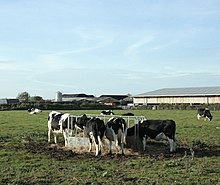
Animals used as livestock are predominantlyherbivorous,the main exceptions being the pig and the chicken which are omnivorous. The herbivores can be divided into "concentrate selectors" which selectively feed on seeds, fruits and highly nutritious young foliage, "grazers" which mainly feed on grass, and "intermediate feeders" which choose their diet from the whole range of available plant material. Cattle, sheep, goats, deer and antelopes areruminants;they digest food in two steps, chewing and swallowing in the normal way, and then regurgitating the semidigested cud to chew it again and thus extract the maximum possible food value.[30] The dietary needs of these animals is mostly met by eating grass. Grasses grow from the base of the leaf-blade, enabling it to thrive even when heavily grazed or cut.[31]
In many climates grass growth is seasonal, for example in the temperatesummeror tropicalrainy season,so some areas of the crop are set aside to be cut and preserved, either ashay(dried grass), or assilage(fermented grass).[32]Other forage crops are also grown and many of these, as well as crop residues, can be ensiled to fill the gap in the nutritional needs of livestock in the lean season.[33]
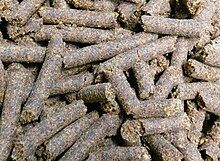
Extensively reared animals may subsist entirely on forage, but more intensively kept livestock will require energy and protein-rich foods in addition. Energy is mainly derived from cereals and cereal by-products, fats and oils and sugar-rich foods, while protein may come from fish or meat meal, milk products,legumesand other plant foods, often the by-products of vegetable oil extraction.[34] Pigs and poultry are non-ruminants and unable to digest thecellulosein grass and other forages, so they are fed entirely on cereals and other high-energy foodstuffs. The ingredients for the animals' rations can be grown on the farm or can be bought, in the form of pelleted or cubed, compound foodstuffs specially formulated for the different classes of livestock, their growth stages and their specific nutritional requirements. Vitamins and minerals are added to balance the diet.[35]Farmed fish are usually fed pelleted food.[35]
Breeding
[edit]The breeding of farm animals seldom occurs spontaneously but is managed by farmers with a view to encouraging traits seen as desirable. These include hardiness, fertility, docility, mothering abilities, fast growth rates, low feed consumption per unit of growth, better body proportions, higher yields, and better fibre qualities. Undesirable traits such as health defects and aggressiveness are selected against.[36][37]
Selective breeding has been responsible for large increases in productivity. For example, in 2007, a typical broiler chicken at eight weeks old was 4.8 times as heavy as a bird of similar age in 1957,[36]while in the thirty years to 2007, the average milk yield of a dairy cow in the United States nearly doubled.[36]
Animal health
[edit]
Good husbandry, proper feeding, andhygieneare the main contributors to animal health on the farm, bringing economic benefits through maximised production. When, despite these precautions, animals still become sick, they are treated withveterinary medicines,by the farmer and theveterinarian.In the European Union, when farmers treat their own animals, they are required to follow the guidelines for treatment and to record the treatments given.[38]Animals are susceptible to a number of diseases and conditions that may affect their health. Some, likeclassical swine fever[39]andscrapie[40]are specific to one type of stock, while others, likefoot-and-mouth diseaseaffect allcloven-hoofedanimals.[41]Animals living under intensive conditions are prone to internal and externalparasites;increasing numbers ofsea liceare affecting farmed salmon in Scotland.[42]Reducing the parasite burdens of livestock results in increased productivity and profitability.[43]
Where the condition is serious, governments impose regulations on import and export, on the movement of stock,quarantinerestrictions and the reporting of suspected cases.Vaccinesare available against certain diseases, and antibiotics are widely used where appropriate. At one time, antibiotics were routinely added to certain compound foodstuffs to promote growth, but this practice is now frowned on in many countries because of the risk that it may lead toantimicrobial resistancein livestock and in humans.[44]

Governments are concerned withzoonoses,diseases that humans may acquire from animals. Wild animal populations may harbour diseases that can affect domestic animals which may acquire them as a result of insufficientbiosecurity.An outbreak ofNipah virusin Malaysia in 1999 was traced back to pigs becoming ill after contact with fruit-eatingflying foxes,their faeces and urine. The pigs in turn passed the infection to humans.[45]Avian fluH5N1is present in wild bird populations and can be carried large distances by migrating birds. This virus is easily transmissible to domestic poultry, and to humans living in close proximity with them. Other infectious diseases affecting wild animals, farm animals and humans includerabies,leptospirosis,brucellosis,tuberculosisandtrichinosis.[46]
Range of species
[edit]There is no single universally agreed definition of which species are livestock. Widely agreed types of livestock include cattle for beef and dairy, sheep, goats, pigs, and poultry. Various other species are sometimes considered livestock, such as horses,[47]while poultry birds are sometimes excluded. In some parts of the world, livestock includes species such as buffalo, and the South American camelids, the alpaca and llama.[48][49][50]Some authorities use much broader definitions to include fish inaquaculture,micro-livestock such asrabbitsandrodentslikeguinea pigs,as well as insects fromhoney beestocrickets raised for human consumption.[51]

Products
[edit]Animals are raised for a wide variety of products, principallymeat,wool,milk,andeggs,but also includingtallow,isinglassandrennet.[52][53]Animals are also kept for more specialised purposes, such as to producevaccines[54]andantiserum(containingantibodies) for medical use.[55]Wherefodderor othercropsare grown alongside animals,manurecan serve as a fertiliser, returning minerals and organic matter to the soil in a semi-closed organic system.[56]
Branches
[edit]Dairy
[edit]
Although all mammals produce milk to nourish their young, the cow is predominantly used throughout the world to produce milk and milk products for human consumption. Other animals used to a lesser extent for this purpose include sheep, goats, camels, buffaloes, yaks, reindeer, horses and donkeys.[57]
All these animals have been domesticated over the centuries, being bred for such desirable characteristics as fecundity, productivity, docility and the ability to thrive under the prevailing conditions. Whereas in the past cattle had multiple functions, modern dairy cow breeding has resulted in specialisedHolstein Friesian-typeanimals that produce large quantities of milk economically.Artificial inseminationis widely available to allow farmers to select for the particular traits that suit their circumstances.[58]
Whereas in the past cows were kept in small herds onfamily farms,grazing pastures and being fed hay in winter, nowadays there is a trend towards larger herds, more intensive systems, the feeding ofsilageand "zero grazing", a system where grass is cut and brought to the cow, which is housed year-round.[59]
In many communities, milk production is only part of the purpose of keeping an animal which may also be used as a beast of burden or to draw a plough, or for the production of fibre, meat and leather, with thedungbeing used for fuel or for the improvement ofsoil fertility.Sheep and goats may be favoured for dairy production in climates and conditions that do not suit dairy cows.[57]
Meat
[edit]
Meat,mainly from farmed animals, is a major source of dietaryproteinand essential nutrients around the world, averaging about 8% of man's energy intake.[60]The actual types eaten depend on local preferences, availability, cost and other factors, with cattle, sheep, pigs and goats being the main species involved. Cattle generally produce a single offspring annually which takes more than a year to mature; sheep and goats often have twins and these are ready for slaughter in less than a year; pigs are more prolific, producing more than one litter of up to about 11[61]piglets each year.[62]Horses, donkeys, deer, buffalo, llamas, alpacas, guanacos and vicunas are farmed for meat in various regions. Some desirable traits of animals raised for meat include fecundity, hardiness, fast growth rate, ease of management and high food conversion efficiency. About half of the world's meat is produced from animals grazing on open ranges or on enclosed pastures, the other half being produced intensively in various factory-farming systems; these are mostly cows, pigs or poultry, and often reared indoors, typically at high densities.[63]
Poultry
[edit]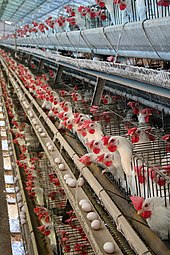
Poultry, kept for their eggs and for their meat, include chickens, turkeys, geese and ducks. The great majority of laying birds used for egg production are chickens. Methods for keeping layers range from free-range systems, where the birds can roam as they will but are housed at night for their own protection, through semi-intensive systems where they are housed in barns and have perches, litter and some freedom of movement, to intensive systems where they are kept in cages. Thebattery cagesare arranged in long rows in multiple tiers, with external feeders, drinkers, and egg collection facilities. This is the most labour saving and economical method of egg production but has been criticised on animal welfare grounds as the birds are unable to exhibit their normal behaviours.[64]
In the developed world, the majority of the poultry reared for meat is raised indoors in big sheds, with automated equipment under environmentally controlled conditions. Chickens raised in this way are known as broilers, and genetic improvements have meant that they can be grown to slaughter weight within six or seven weeks of hatching. Newly hatched chicks are restricted to a small area and given supplementary heating. Litter on the floor absorbs the droppings and the area occupied is expanded as they grow. Feed and water is supplied automatically and the lighting is controlled. The birds may be harvested on several occasions or the whole shed may be cleared at one time.[65]
A similar rearing system is usually used for turkeys, which are less hardy than chickens, but they take longer to grow and are often moved on to separate fattening units to finish.[66]Ducks are particularly popular in Asia and Australia and can be killed at seven weeks under commercial conditions.[67]
Aquaculture
[edit]
Aquaculture has been defined as "the farming of aquatic organisms including fish, molluscs, crustaceans and aquatic plants and implies some form of intervention in the rearing process to enhance production, such as regular stocking, feeding, protection from predators, etc. Farming also implies individual orcorporate ownershipof the stock being cultivated. "[68]In practice it can take place in the sea or in freshwater, and be extensive or intensive. Whole bays, lakes or ponds may be devoted to aquaculture, or the farmed animal may be retained in cages (fish),artificial reefs,racks or strings (shellfish). Fish and prawns can be cultivated inrice paddies,either arriving naturally or being introduced, and both crops can be harvested together.[69]
Fish hatcheriesprovide larval and juvenile fish, crustaceans and shellfish, for use in aquaculture systems. When large enough these are transferred to growing-on tanks and sold to fish farms to reach harvest size. Some species that are commonly raised in hatcheries includeshrimps,prawns,salmon,tilapia,oystersandscallops.Similar facilities can be used to raise species with conservation needs to be released into the wild, or game fish for restocking waterways. Important aspects of husbandry at these early stages include selection of breeding stock, control of water quality and nutrition. In the wild, there is a massive amount of mortality at the nursery stage; farmers seek to minimise this while at the same time maximising growth rates.[70]
Insects
[edit]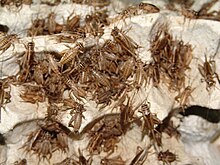
Beeshave been kept in hives since at least theFirst Dynasty of Egypt,five thousand years ago,[71]and man had been harvesting honey from the wild long before that. Fixed comb hives are used in many parts of the world and are made from any locally available material.[72]In more advanced economies, where modern strains of domestic bee have been selected for docility and productiveness, various designs of hive are used which enable the combs to be removed for processing and extraction of honey. Quite apart from thehoneyandwaxthey produce, honey bees are importantpollinatorsof crops and wild plants, and in many places hives are transported around the countryside to assist in pollination.[73]
Sericulture,the rearing of silkworms, was first adopted by the Chinese during theShang dynasty.[74]The only species farmed commercially is the domesticatedsilkmoth.When it spins itscocoon,each larva produces an exceedingly long, slender thread of silk. The larvae feed onmulberry leavesand in Europe, only one generation is normally raised each year as this is a deciduous tree. In China, Korea and Japan however, two generations are normal, and in the tropics, multiple generations are expected. Most production of silk occurs in the Far East, with a synthetic diet being used to rear the silkworms in Japan.[75]
Insects form part of the human diet in many cultures.[76]In Thailand,cricketsare farmed for this purpose in the north of the country, andpalm weevillarvae in the south. The crickets are kept in pens, boxes or drawers and fed on commercial pelleted poultry food, while the palm weevil larvae live oncabbage palmandsago palmtrees, which limits their production to areas where these trees grow.[77]Another delicacy of this region is thebamboo caterpillar,and the best rearing and harvesting techniques in semi-natural habitats are being studied.[77]
Effects
[edit]
Environmental impact
[edit]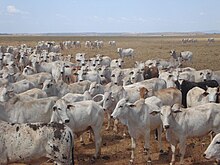
Animal husbandry has a significant impact on the world environment. Both production and consumption of animal products have increased rapidly. Since 1950, meat production has tripled, whereas the production of dairy products doubled and that of eggs almost increased fourfold.[78]Meanwhile, meat consumption has nearly doubled worldwide. Developing countries had a surge in meat consumption, particularly of monogastric livestock.[79]Animal husbandry drives climate change, ocean acidification, and biodiversity loss, and kills 60 billion animals annually.[80]It uses between 20 and 33% of the world's fresh water,[81]Livestock, and the production of feed for them, occupy about a third of the Earth's ice-free land.[82]Livestock production contributes to speciesextinction,desertification,[83]andhabitat destruction.[84]and is the primary driver of theHolocene extinction.[85][86][87][88][89]Some 70% of the agricultural land and 30% of Earth's land surface is involved directly or indirectly in animal husbandry.[90]Habitat is destroyed by clearing forests and converting land to grow feed crops and for grazing, while predators and herbivores are frequently targeted because of a perceived threat to livestock profits; for example, animal husbandry causes up to 91% of thedeforestation in the Amazon region.[91]In addition, livestock producegreenhouse gases.Cows produce some 570 million cubic metres of methane per day,[92]that accounts for 35 to 40% of the overallmethane emissionsof the planet.[93]Further, livestock production is responsible for 65% of all human-related emissions ofnitrous oxide.[93][94][60]
Animal welfare
[edit]Since the 18th century, people have become increasingly concerned aboutthe welfare of farm animals.Possible measures of welfare includelongevity,behavior,physiology,reproduction,freedom fromdisease,and freedom fromimmunosuppression.Standards and laws for animal welfare have been created worldwide, broadly in line with the most widely held position in the western world, a form ofutilitarianism:that it ismorally acceptablefor humans to use non-human animals, provided that no unnecessary suffering is caused, and that the benefits to humans outweigh the costs to the livestock. An opposing view is thatanimals have rights,should not be regarded as property, are not necessary to use, and should never be used by humans.[95][96][97][98][99]Live exportof animals has risen to meet increased global demand for livestock such as in theMiddle East.Animal rights activists have objected to long-distance transport of animals; one result was the banning of live exports from New Zealand in 2003.[100]
In culture
[edit]
Since the 18th century, the farmerJohn Bullhas representedEnglish national identity,first inJohn Arbuthnot's political satires, and soon afterwards in cartoons byJames Gillrayand others includingJohn Tenniel.He likes food, beer, dogs, horses, andcountry sports;he is practical and down to earth, and anti-intellectual.[101]
Farm animals are widespread in books and songs for children; the reality of animal husbandry is often distorted, softened, or idealized, giving children an almost entirely fictitious account of farm life. The books often depict happy animals free to roam in attractive countryside, a picture completely at odds with the realities of the impersonal, mechanized activities involved in modernintensive farming.[102]

Pigs, for example, appear in several ofBeatrix Potter's "little books", as Piglet inA.A. Milne'sWinnie the Poohstories, and somewhat more darkly (with a hint of animals going to slaughter) as Babe inDick King-Smith'sThe Sheep-Pig,and as Wilbur inE. B. White'sCharlotte's Web.[103]Pigs tend to be "bearers of cheerfulness, good humour and innocence". Many of these books are completelyanthropomorphic,dressing farm animals in clothes and having them walk on two legs, live in houses, and perform human activities.[102]Thechildren's song"Old MacDonald Had a Farm"describes a farmer named MacDonald and the various animals he keeps, celebrating the noises they each make.[104]
Many urban children experience animal husbandry for the first time at apetting farm;in Britain, some five million people a year visit a farm of some kind. This presents some risk ofinfection,especially if children handle animals and then fail towash their hands;a strain ofE. coliinfected93 people who had visited a British interactive farm in an outbreak in 2009.[105]Historic farms such as those in the United States offer farmstays and "a carefully curated version of farming to those willing to pay for it",[106]sometimes giving visitors a romanticised image of apastoralidyll from an unspecified time in the pre-industrial past.[106]
See also
[edit]- Animal–industrial complex
- Agribusiness
- Fishery
- Food vs. feed
- Industrial agriculture
- Wildlife farming
- Zootechnics
Notes
[edit]- ^Both the name Bull and the reference to bacon indicate the archetypal livestock farmer.
References
[edit]Citations
[edit]- ^Merriam-Webster's Collegiate Dictionary(11 ed.). Springfield, MA: Merriam-Webster, Incorporated. 2004. p. 607.ISBN0-87779-825-7.
- ^Clutton-Brock, Juliet(1999).A Natural History of Domesticated Mammals.Cambridge University Press. pp. 1–2.ISBN978-0-521-63495-3.
- ^abcde"History of the domestication of animals".Historyworld.Retrieved3 June2017.
- ^Caliebe, Amke; et al. (16 March 2017)."Insights into early pig domestication provided by ancient DNA analysis".Scientific Reports.7:44550.Bibcode:2017NatSR...744550C.doi:10.1038/srep44550.PMC5353713.PMID28300151.
- ^Orozco-terWengel, Pablo (20 March 2018)."New light shed on the domestication history of sheep and goats".Cardiff University.
- ^McTavish, E.J.; Decker, J.E.; Schnabel, R.D.; Taylor, J.F.; Hillis, D.M. (2013)."New World cattle show ancestry from multiple independent domestication events".PNAS.110(15).National Academy of Sciences:1398–1406.Bibcode:2013PNAS..110E1398M.doi:10.1073/pnas.1303367110.PMC3625352.PMID23530234.
Cattle were independently domesticated from the aurochs, a wild bovine species, in the vicinity of the current countries of Turkey and Pakistan ~10,000 y ago.
- ^Gupta, Anil K. inOrigin of agriculture and domestication of plants and animals linked to early Holocene climate amelioration,Current Science, Vol. 87, No. 1, 10 July 2004 59. Indian Academy of Sciences.
- ^Adler, Jerry; Lawler, Andrew (1 June 2012)."How the Chicken Conquered the World".Smithsonian Magazine.Retrieved5 June2017.
- ^Sapir-Hen, Lidar; Ben-Yosef, Erez (2013)."The Introduction of Domestic Camels to the Southern Levant: Evidence from the Aravah Valley"(PDF).Tel Aviv.40(2): 277–85.doi:10.1179/033443513x13753505864089.S2CID44282748.
- ^Manuelian, Peter der (1998).Egypt: The World of the Pharaohs.Cologne: Könemann. p. 381.ISBN978-3-89508-913-8.
- ^Nicholson, Paul T. (2000).Ancient Egyptian Materials and Technology.Cambridge: Cambridge University Press. p. 409.ISBN978-0-521-45257-1.
- ^Clutton-Brock, Juliet(1981).Domesticated animals from early times.Heinemann. p. 145.ISBN9780434139507.
- ^O'Connor, Terry (30 September 2014)."Livestock and animal husbandry in early medieval England"(PDF).Quaternary International.346:109–18.Bibcode:2014QuInt.346..109O.doi:10.1016/j.quaint.2013.09.019.
- ^The Anglo-Saxon Chronicle.Translated byGiles, J.A.;Ingram, J. Project Gutenberg. 1996.
- ^"Interpreting Domesday".The National Archives.Retrieved26 May2017.
- ^"The progress of farming in Medieval Europe".History of Agriculture.University of Reading. Archived fromthe originalon 5 June 2023.Retrieved28 May2017.
- ^Campbell, Bruce M.S.; Overton, M. (1993). "A New Perspective on Medieval and Early Modern Agriculture: Six Centuries of Norfolk Farming, c. 1250 – c. 1850".Past and Present(141): 38–105.doi:10.1093/past/141.1.38.
- ^Crosby, Alfred."The Columbian Exchange".History Now.The Gilder Lehrman Institute of American History.Retrieved28 May2017.
- ^"Robert Bakewell (1725–1795)".BBC History.Retrieved20 July2012.
- ^"English Longhorn".The Cattle Site.Retrieved26 May2017.
- ^Pykala, Juha (2000). "Mitigating Human Effects of European Biodiversity Through Traditional Animal Husbandry".Conservation Biology.14(3): 705–12.Bibcode:2000ConBi..14..705P.doi:10.1046/j.1523-1739.2000.99119.x.S2CID53393839.
- ^abWebster, John (2013).Animal Husbandry Regained: The Place of Farm Animals in Sustainable Agriculture.Routledge. pp. 4–10.ISBN978-1-84971-420-4.
- ^Blench, Roger (17 May 2001).'You can't go home again' – Pastoralism in the new millennium(PDF).London, UK: Overseas Development Institute. p. 12. Archived fromthe original(PDF)on 1 February 2012.Retrieved4 June2017.
- ^Starrs, Paul F. (2000).Let the Cowboy Ride: Cattle Ranching in the American West.JHU Press. pp. 1–2.ISBN978-0-8018-6351-6.
- ^Levinson, David; Christensen, Karen (2003).Encyclopedia of Community: From the Village to the Virtual World.Sage. p. 1139.ISBN978-0-7619-2598-9.
- ^Rebanks, James (2015).The Shepherd's Life.Penguin: Random House. p. 286.ISBN978-0-14-197936-6.
- ^Silbergeld, Ellen K.; Graham, Jay; Price, Lance B. (2008)."Industrial food animal production, antimicrobial resistance, and human health".Annual Review of Public Health.29:151–169.doi:10.1146/annurev.publhealth.29.020907.090904.PMID18348709.
- ^Meyer, Vernon M.; Driggers, L. Bynum; Ernest, Kenneth; Ernest, Debra."Swine Growing-Finishing Units"(PDF).Pork Industry handbook.Purdue University Cooperative Extension Service.Retrieved17 May2017.
- ^Blount, W. P. (2013).Intensive Livestock Farming.Elsevier. pp. 360–362.ISBN978-1-4831-9565-0.
- ^Dryden, Gordon McL. (2008).Animal Nutrition Science.CABI. pp. 1–3.ISBN978-1-78064-056-3.
- ^Attenborough, David(1984).The Living Planet.British Broadcasting Corporation.pp. 113–14.ISBN978-0-563-20207-3.
- ^United States Agricultural Research Service, Animal Husbandry Research Division (1959).Hay crop silage.
{{cite book}}:CS1 maint: numeric names: authors list (link) - ^Jianxin, Liu; Jun, Guo."Ensiling crop residues".Animal production based on crop residues.FAO.Retrieved18 May2017.
- ^Dryden, Gordon McL. (2008).Animal Nutrition Science.CABI. pp. 16–19.ISBN978-1-84593-412-5.
- ^ab"What farm animals eat".Food Standards Agency.Retrieved18 May2017.
- ^abcTurner, Jacky (2010).Animal Breeding, Welfare and Society.Routledge. p. Introduction.ISBN978-1-136-54187-2.
- ^Jarman, M.R.; Clark, Grahame; Grigson, Caroline; Uerpmann, H.P.; Ryder, M.L. (1976). "Early Animal Husbandry".Philosophical Transactions of the Royal Society of London, Series B.275(936): 85–97.Bibcode:1976RSPTB.275...85J.doi:10.1098/rstb.1976.0072.
- ^"Farmers".European Platform for the Responsible Use of Medicines in Animals. 2010. Archived fromthe originalon 26 May 2017.Retrieved18 May2017.
- ^"Classical swine fever"(PDF).The Center for Food Security and Public Health.Retrieved20 May2017.
- ^"Scrapie Fact Sheet".National Institute for Animal Agriculture. 2001. Archived fromthe originalon 12 December 2020.Retrieved6 June2018.
- ^"Foot-and-mouth".The Cattle Site.Retrieved20 May2017.
- ^Fraser, Douglas (14 February 2017)."Scottish salmon farming's sea lice 'crisis'".BBC.Retrieved20 May2017.
- ^"Parasite control".Animal Health Ireland. Archived fromthe originalon 14 May 2017.Retrieved20 May2017.
- ^Innes, Gabriel K.; Randad, Pranay R.; Korinek, Anton; Davis, Meghan F.; Price, Lance B.; So, Anthony D.; Heaney, Christopher D. (2020-04-02)."External Societal Costs of Antimicrobial Resistance in Humans Attributable to Antimicrobial Use in Livestock".Annual Review of Public Health.41:141–157.doi:10.1146/annurev-publhealth-040218-043954.ISSN0163-7525.PMC7199423.PMID31910712.
- ^Chua, K.B.; Chua, B.H.; Wang, C.W. (2002). "Anthropogenic deforestation, El Niño and the emergence of Nipah virus in Malaysia".The Malaysian Journal of Pathology.24(1): 15–21.PMID16329551.
- ^Norrgren, Leif; Levengood, Jeffrey M. (2012).Ecology and Animal Health.Baltic University Press. pp. 103–04.ISBN978-91-86189-12-9.
- ^"Welcome to Equine Research, Education, and Outreach".University of Kentucky.Retrieved18 August2017.
- ^Ferguson, W.; Ademosun, A.A.; von Kaufmann, R.; Hoste, C.; Rains, A. Blair."5. Livestock resources and management".Food and Agriculture Organization.Retrieved24 May2017.
- ^"Livestock Species".Texas A&M University Department of Agriculture and Life Sciences.Retrieved24 May2017.
- ^Steinfeld, H.; Mäki-Hokkonen, J."A classification of livestock production systems".Food and Agriculture Organization.Retrieved24 May2017.
- ^Myers, Melvin L."Chapter 70 – Livestock Rearing".Encyclopaedia of Occupational Health and Safety.Retrieved24 May2017.
- ^Unklesbay, Nan (1992).World Food and You.Routledge. pp. 179ff.
- ^Walling, Philip (2014).Counting Sheep: A Celebration of the Pastoral Heritage of Britain.Profile Books. p. 16.ISBN978-1-84765-803-6.
- ^Bae, K.; Choi, J.; Jang, Y.; Ahn, S.; Hur, B. (2009)."Innovative vaccine production technologies: the evolution and value of vaccine production technologies".Arch Pharm Res.32(4): 465–80.doi:10.1007/s12272-009-1400-1.PMID19407962.S2CID9066150.
- ^Leenaars, Marlies; Hendriksen, Coenraad F.M. (2005)."Critical Steps in the Production of Polyclonal and Monoclonal Antibodies: Evaluation and Recommendations".ILAR Journal.46(3): 269–79.doi:10.1093/ilar.46.3.269.PMID15953834.
- ^Godinho, Denise."Animal Husbandry in Organic Agriculture".Food and Agriculture Organization. Archived fromthe originalon 2017-05-18.Retrieved25 May2017.
- ^ab"Dairy animals".Dairy production and products.FAO.Retrieved23 May2017.
- ^"Breeding".Dairy production and products.FAO.Retrieved23 May2017.
- ^"Housing in a zero grazing system"(PDF).Republic of Kenya: Ministry of Livestock Development. Archived fromthe original(PDF)on 28 January 2018.Retrieved5 June2017.
- ^abMcAfee, Alison J.; McSorley, Emeir M.; Cuskelly, Geraldine J.; Moss, Bruce W.; Wallace, Julie M. W.; Bonham, Maxine P.; Fearon, Anna M. (January 2010)."Red meat consumption: An overview of the risks and benefits".Meat Science.84(1): 1–13.doi:10.1016/j.meatsci.2009.08.029.PMID20374748.
- ^Aherne, Frank; Kirkwood, Roy (16 February 2001)."Factors Affecting Litter Size".The Pig Site.
- ^Gregory, Neville G.; Grandin, Temple (2007).Animal Welfare and Meat Production.CABI. pp. 1–2.ISBN978-1-84593-216-9.
- ^Miller, G. Tyler; Spoolman, Scott (2014).Sustaining the Earth.Cengage Learning. p. 138.ISBN978-1-285-76949-3.
- ^"About egg laying hens".Compassion in World Farming.Retrieved26 May2017.
- ^"Growing meat chickens".Australian Chicken Meat Federation. 2013. Archived fromthe originalon 2017-05-15.Retrieved26 May2017.
- ^Sherwin, C.M. (2010). "Turkeys: Behavior, Management and Well-Being". InThe Encyclopaedia of Animal Science.Wilson G. Pond and Alan W. Bell (Eds). Marcel Dekker. pp. 847–49
- ^"Duck".Poultry Hub.Archived fromthe originalon 4 May 2017.Retrieved26 May2017.
- ^"Global Aquaculture Production".Fishery Statistical Collections.Food and Agriculture Organization of the United Nations.Retrieved26 May2017.
- ^"Fish culture in rice fields".Fishery Statistical Collections.Food and Agriculture Organization of the United Nations.Retrieved26 May2017.
- ^Mosig, John; Fallu, Ric (2004).Australian Fish Farmer: A Practical Guide to Aquaculture.Landlinks Press. pp. 25–28.ISBN978-0-643-06865-0.
- ^"Ancient Egypt: Bee-keeping".Reshafim.org.il.6 June 2003. Archived fromthe originalon 9 March 2016.Retrieved22 May2017.
- ^"Fixed combs".Bees for Development. Archived fromthe originalon 18 May 2011.Retrieved22 May2017.
- ^Jabr, Ferris (1 September 2013)."The Mind-Boggling Math of Migratory Beekeeping".Scientific American.Retrieved22 May2017.
- ^Barber, E.J.W. (1992).Prehistoric textiles: the development of cloth in the Neolithic and Bronze Ages with special reference to the Aegean.Princeton University Press. p. 31.ISBN978-0-691-00224-8.
- ^Hill, Dennis S. (2012).The Economic Importance of Insects.Springer Science & Business Media. pp. 21–22.ISBN978-94-011-5348-5.
- ^Carrington, Damian (1 August 2010)."Insects could be the key to meeting food needs of growing global population".The Guardian.
- ^abSix-legged Livestock: Edible insect farming, collection and marketing in Thailand(PDF).Bangkok: Food and Agriculture Organization of the United Nations. 2013.ISBN978-92-5-107578-4.
- ^Speedy, Andrew W. (2003-11-01)."Global Production and Consumption of Animal Source Foods".The Journal of Nutrition.133(11): 4048S–4053S.doi:10.1093/jn/133.11.4048s.ISSN0022-3166.PMID14672310.
- ^Sans, P.; Combris, P. (November 2015)."World meat consumption patterns: An overview of the last fifty years (1961–2011)".Meat Science.109:106–111.doi:10.1016/j.meatsci.2015.05.012.ISSN0309-1740.PMID26117396.
- ^Boscardin, Livia (12 July 2016)."Greenwashing the Animal-Industrial Complex: Sustainable Intensification and Happy Meat".3rd ISA Forum of Sociology, Vienna, Austria.ISAConf.confex.Retrieved10 August2021.
- ^Mekonnen, Mesfin M.; Hoekstra, Arjen Y. (2012)."A Global Assessment of the Water Footprint of Farm Animal Products"(PDF).Water Footprint Network. Archived fromthe original(PDF)on 2015-03-11.Retrieved2015-10-05.
- ^"Livestock a major threat to environment".Food and Agriculture Organizations of the United Nations. Archived fromthe originalon 2008-03-28.Retrieved2015-10-05.
- ^Whitford, Walter G. (2002).Ecology of desert systems.Academic Press. p. 277.ISBN978-0-12-747261-4.
- ^"Unit 9: Biodiversity Decline // Section 7: Habitat Loss: Causes and Consequences".Annenberg Learner. Archived fromthe originalon 2018-10-28.Retrieved2020-06-18.
- ^Ripple WJ, Wolf C, Newsome TM, Galetti M, Alamgir M, Crist E, Mahmoud MI, Laurance WF (13 November 2017)."World Scientists' Warning to Humanity: A Second Notice"(PDF).BioScience.67(12): 1026–1028.doi:10.1093/biosci/bix125.hdl:11336/71342.Archived fromthe original(PDF)on 15 December 2019.Retrieved10 August2021.
- ^Carrington, Damian (February 3, 2021)."Plant-based diets crucial to saving global wildlife, says report".The Guardian.RetrievedAugust 5,2021.
- ^McGrath, Matt (6 May 2019)."Humans 'threaten 1m species with extinction'".BBC.Retrieved3 August2021.
- ^Machovina, B.; Feeley, K. J.; Ripple, W. J. (2015). "Biodiversity conservation: The key is reducing meat consumption".Science of the Total Environment.536:419–431.Bibcode:2015ScTEn.536..419M.doi:10.1016/j.scitotenv.2015.07.022.PMID26231772.
- ^Smithers, Rebecca (5 October 2017)."Vast animal-feed crops to satisfy our meat needs are destroying planet".The Guardian.Retrieved5 October2017.
- ^Ilea, Ramona Cristina (2008-12-11)."Intensive Livestock Farming: Global Trends, Increased Environmental Concerns, and Ethical Solutions".Journal of Agricultural and Environmental Ethics.22(2): 153–167.doi:10.1007/s10806-008-9136-3.S2CID154306257.
- ^Margulis, Sergio (2003).Causes of Deforestation of the Brazilian Rainforest.World Bank Working Papers. Washington: World Bank Publications.doi:10.1596/0-8213-5691-7.ISBN978-0-8213-5691-3.
- ^Ross, Philip (2013)."Cow farts have 'larger greenhouse gas impact' than previously thought; methane pushes climate change".International Business Times.
- ^abSteinfeld, H.; Gerber, P.; Wassenaar, T.; Castel, V.; Rosales, M.; de Haan, C. (2006)."Livestock's Long Shadow: Environmental Issues and Options".FAO.Retrieved13 December2017.
- ^Stoll-Kleemann, Susanne; O'Riordan, Tim (23 April 2015)."The Sustainability Challenges of Our Meat and Dairy Diets".Environment: Science and Policy for Sustainable Development.57(3): 34–48.Bibcode:2015ESPSD..57c..34S.doi:10.1080/00139157.2015.1025644.S2CID153809456.
- ^Grandin, Temple(2013)."Animals are not things: A view on animal welfare based on neurological complexity"(PDF).Trans-Scripts 3: An Interdisciplinary Online Journal in Humanities And Social Sciences at UC Irvine.Archived fromthe original(PDF)on 19 August 2014.
- ^Hewson, C.J. (2003)."What is animal welfare? Common definitions and their practical consequences".The Canadian Veterinary Journal.44(6): 496–99.PMC340178.PMID12839246.
- ^Broom, D.M. (1991). "Animal welfare: concepts and measurement".Journal of Animal Science.69(10): 4167–75.doi:10.2527/1991.69104167x.PMID1778832.
- ^Garner, R. (2005).Animal Ethics.Polity Press.
- ^Regan, T. (1983).The Case for Animal Rights.University of California Press.ISBN9780520049048.
- ^"'This one has heat stress': the shocking reality of live animal exports ".The Guardian.30 July 2018.
- ^Johnson, Ben."John Bull".Historic UK.Retrieved26 May2017.
- ^abHoult-Saros, Stacy E. (2016).The Mythology of the Animal Farm in Children's Literature: Over the Fence.Le xing ton Books. pp. 18–29.ISBN978-1-4985-1978-6.
- ^"Livestock in literature".Compassion in World Farming. 1 October 2015.
- ^Waltz, Robert B.; Engle, David G. (2016)."Old MacDonald Had a Farm".The Traditional Ballad Index.Archived fromthe originalon 12 May 2016.Retrieved18 May2017.
- ^Laurance, Jeremy (15 June 2010)."Children's Petting Farms Face Tough New Rules".The Independent.Archivedfrom the original on 2022-05-07.
- ^abSearle, Sarah (30 June 2014)."Stop Romanticizing Farms".Modern Farmer.
Sources
[edit]- Saltini, Antonio.Storia delle scienze agrarie,4 vols, Bologna 1984–89,ISBN88-206-2412-5,88-206-2413-3,88-206-2414-1,88-206-2415-X.
- Clutton Brock, Juliet.The walking larder. Patterns of domestication, pastoralism and predation,Unwin Hyman, London 1988.
- Clutton Brock, Juliet.Horse power: a history of the horse and donkey in human societies,National history Museum publications, London 1992.
- Fleming, George;Guzzoni, M.Storia cronologica delle epizoozie dal 1409 av. Cristo sino al 1800,in Gazzetta medico-veterinaria, I–II, Milano 1871–72.
- Hall, S;Clutton Brock, Juliet.Two hundred years of British farm livestock,Natural History Museum Publications, London 1988.
- Janick, Jules; Noller, Carl H.; Rhyker, Charles L.The Cycles of Plant and Animal Nutrition,in Food and Agriculture, Scientific American Books, San Francisco 1976.
- Manger, Louis N.A History of the Life Sciences,M. Dekker, New York, Basel 2002.

